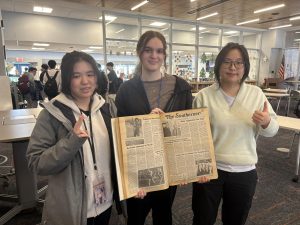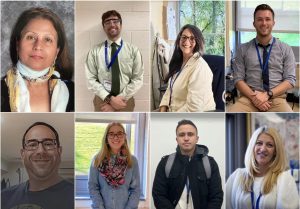The Truth Behind the Theory: Critical Race in Our Nation and Community
June 21, 2022
In the past year, the term “critical race theory” went from a relatively unknown concept to an issue that’s shaping national events and conversations. It’s become a key talking point for political candidates and a key deciding issue in elections. It’s become a matter of heated debate at school board meetings. It’s become a policy issue, with legislators across the country seeking to ban it in schools. It’s everywhere. This raises the question: what is critical race theory?
According to Florida Governor Ron DeSantis, it’s “state-sanctioned racism.” According to Texas Senator Ted Cruz it “says every white person is a racist.” And according to President Trump’s administration, it’s “divisive, anti-American propaganda” and “a Marxist doctrine holding that America is a wicked and racist nation, that even young children are complicit in oppression, and that our entire society must be radically transformed.”
But critical race theory isn’t some new threat to American society that’s infiltrating classrooms across the nation and poisoning the minds of America’s youth: it’s a graduate level academic theory developed in the 1970s. And according to Kimberle Crenshaw, a leading scholar in critical race theory and a law professor at Columbia University and UCLA, critical race theory is actually “a way of seeing, attending to, accounting for, tracing, and analyzing the ways that race is produced,” and “the ways that racial inequality is facilitated, and the ways that our history has created these inequalities that now can be almost effortlessly reproduced unless we attend to the existence of these inequalities.” So, no, critical race theory is not being taught in elementary, middle, and high schools.
If critical race theory has been around since the 1970s and is a graduate-level academic theory, why did critical race theory become a national concern just recently? It all comes back to media coverage. In 2020, critical race theory was cited 132 times on Fox News. As people began paying attention, it started being discussed more and more. In February, it was mentioned 51 times. Then, 139 times in March, 314 times in April, 589 times in May, and 737 times in the first 3 weeks of June: essentially, the number of mentions doubled monthly. Critical race theory wasn’t considered a threat to freedom and democracy since its conception, but recently, it’s been deliberately constructed to become one.
In many places, schools are teaching the history and structures of racism and leading initiatives for diversity, equity, and inclusion. And in many places, people have taken serious issue with this curriculum. Right here in Great Neck, many people have taken serious issue with it.
At Great Neck North High, an 11th grade English teacher taught a lesson on racism and white fragility and had students take a pledge to work towards becoming antiracists. At the most recent school board meeting on November 17th, 2021, parents and students spoke up, arguing against the teaching of racism in the classroom. At various points during the meeting, the room was filled with hecklers and chaos, leading the board to take a recess. Board President Sassouni then stated that it’s “very unusual for this board to ever have had a recess,” saying it is a “sad indicator” for the community. “I’m proud of a community that can actually come out and have intelligent conversation and debate,” Sassouni said. “I think that it is actually a sign of health, democracy, and of Great Neck. What is not a sign of health is utter disrespect …I think that we should hold ourselves and each other to higher standards than some of those that were exhibited this evening which are going to cause me a great deal of despair about my leadership here.”
The truth is, racism is systemic and racial disparities persist across all sectors of American life. There are disparities in health: black women die 3x more often giving birth and the average lifespan for a white male is 76.4 years compared to 71.9 years for a black male (CDC). There are disparities in education: black students are 6x more likely to face out of school suspensions than white students and black students have an average graduation rate of 79%, compared to a national average of 85%. There are disparities in the workforce: the black unemployment rate is 16.8% compared to a national average of 13.3% and only 4 Fortune 500 CEOs are black. There are disparities in income: black median income is $40,258 compared to a national average of $61,372. And there are disparities in criminal justice: black men are 2.5x more likely to be killed by police than white men.
These issues exist. Ignoring them doesn’t mean they’ll go away and learning about them doesn’t mean villainizing America or blaming all white people. If we don’t learn about our history and the inequities of the past and the present, it’s impossible for us to make racial progress and work towards a more just and equitable society.
Great Neck has its own history of racism. During integration, there was a proposal to bus inner city minority students to Great Neck schools. Many residents advocated passionately for it, but among Great Neck residents, there was an uproar of resistance and refusal. Ultimately, the plan wasn’t implemented because it was decided that Great Neck was too hostile and divisive an environment for minority students. During districting, the school district decided to exclude Spinney Hill, a government housing project with low-income BIPOC residents but included the nearby wealthy and predominantly white suburbs. This obviously isn’t the fault of Great Neck residents today, but it’s a part of our history that shaped our community, whether we like it or not.
But Great Neck also has a history of educated and engaged young people rising up for racial justice. During the civil rights movement, students right here at Great Neck South High, worked tirelessly for and believed strongly in civil rights. In 1962, Great Neck high school students formed the “Great Neck Youth Committee for Civil Rights” to further integration efforts in Great Neck. Ruth Schwartz, the secretary of CORE, a national civil rights organization, came to speak to the committee, and when she did, she brought light to the economic plight of African Americans in this country and in this town: in 1958, black workers earned 58% of what their white coworkers did, and a study in Great Neck found that black people coming out of high school were going into domestic and menial labor jobs. Sealtest Dairy Corporation, a corporation, only employed 19 black and Puerto Rican workers, all of whom worked in menial positions. A CORE negotiating team asked that Sealtest hire at least 10 black or Puerto Ricans within the next month, plan to have a more equitable balance within the company in the future, hire a minimum of 50 workers of color within the next year, and guarantee to hold follow up meetings every 90 days. But Sealtest refused, and when they did, CORE started a boycott. Great Neck students and members of the committee made it their first priority to participate and encourage others to participate in the boycott against Sealtest Dairy Corporation.
The group also decided to take action to deal with discrimination closer to home. In Long Beach, an investigation revealed that the 1,000 people living in Long Beach all lived within an area of four-square blocks and within that area, many houses were in poor condition: without heat, electricity, or bathrooms. Then, black residents faced price gouging: the average monthly rent was $192, which translates to $1,704 today. After repeated protests to the authorities failed to result in any changes, CORE and the NAACP decided to approach a major slumlord and demand that he begin repairs in housing within a week and slash rents in half. Just like Sealtest, he refused. The negotiators planned to occupy his butcher shop until he agreed and Long Island CORE requested the assistance of the Great Neck Youth Committee for Civil Rights in the effort. And so they assisted. On the first day, students picketed, and when the picketers refused to leave without an agreement, they were physically removed by police, placed under arrest for disorderly conduct, and later released into the custody of their lawyers, but no students got arrested. On the second day, 20 Great Neck students and even a social studies teacher at Great Neck, Mr. David Parker, joined the picket line and 4 other Great Neck students joined the sit-in at the clothing shop of another slumlord. On the third day, students participated in a self help project in the slums and helped to remove debris from a house that burned down a year before. During the Long Beach protests and demonstrations, 3 GNS students actually ended up being arrested for “disturbing the peace” but were released to their lawyers after spending a day in jail. The committee also expanded their activities into the local black community to share their ideas and support for overcoming discrimination: they visited churches and spoke to ministers, congregations, and youth groups and had direct discussions with people through means like door to door campaigns.
Students also decided to take action and support the civil rights movement through the school itself. Within school, students worked to provide aid to civil rights causes: in 1962, GNS students participated in a drive held by the NAACP council to provide aid to the 1,000 black families who had been living in tents and in need of food and water after they had been evicted from their homes in Tennessee simply because they registered to vote. That same year, Great Neck South High donated $305 ($2,718.69 today) to CORE. In 1966, students planned a civil rights concert to raise funds for Long Island CORE and also donated over $400 to civil rights organizations such as CORE and the Student Nonviolent Coordinating Committee. Great Neck South High brought in many prominent civil rights leaders to educate students: our school hosted Jack Greenberg, chairman of NAACP’s legal defense fund, as well as the president of Long Island CORE, Lincoln Lynch. In 1963, over a thousand people attended the symposium titled “The Negro Artist Looks at America”, which was held in our auditorium. John Killens, author of Black Man’s Burden, Ossie Davis, actress in The Raisin in the Sun and the Balcony, and James Baldwin, a prominent writer and activist all came to our school to speak about the black art and civil rights. Also in 1963, the Southerner published an interview with James Meredith, the first black student to attend the University of Mississippi and a civil rights movement figure, writer, political adviser, and Air Force veteran.
Great Neck has a history of people using their voices for positive change. Today, we have a choice to continue that tradition and build onto the progress that each generation has made before us. But it all starts with learning our history and confronting problems head on, however uncomfortable that may be. With an understanding of how systems of oppression affect historical and contemporary relations, we can and will be empowered to take action for progress.







